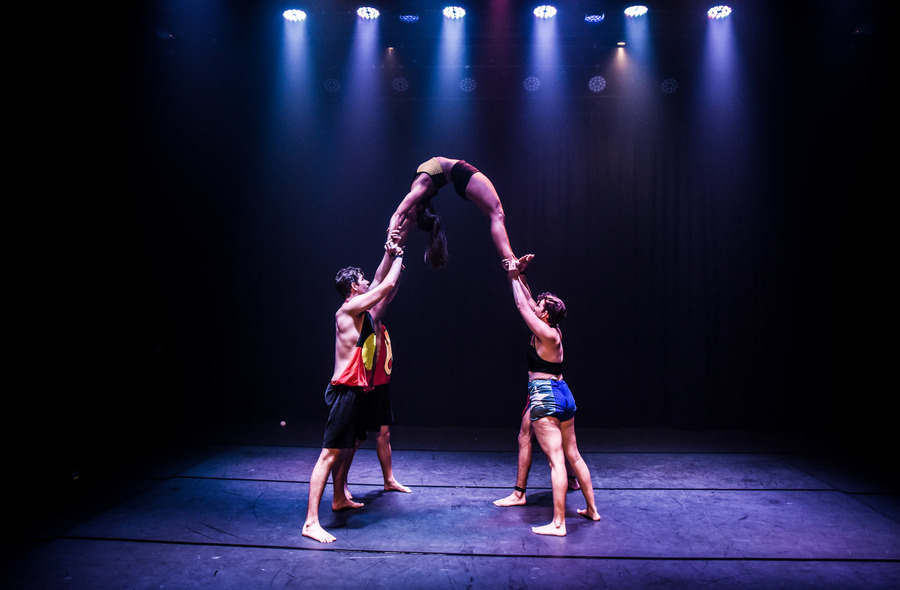Speaking through Circus: Harley Mann and Natano Fa’anana
Waka Waka man Harley Mann and Natano Fa’anana talk about the importance of Indigenous storytelling through circus

Circus and physical theatre has always been one of the most accessible forms of performance. Not bound by language, culture and story are told through movements in the body which are relatable to all. Harley Mann is director of Social Staples, a collaborative modern circus piece which identifies serious social issues in a non-threatening way.
"Physical performance provides a way for people to be less confronted," says Mann. "I think in theatre when things are thrown in your face it can be hard to take them on board. We work to get the audience on board first and then hit them with the message which is quite important to listen to and act on."
Social Staples uses the levity of their physical actions to address personal issues, which were raised in a collaborative process. "We created the show to try to tackle social issues," says Mann, "things us young people have identified as factors in our society. We try to use circus as medium to inform our audience of these issues."
Mann’s own story which he conveys through the show is one of identity, being a fair skinned, white-passing Indigenous man. "How has that shaped me as a person?" he says. "How is my identity different from the modern day’s idea of men in society, or what men should be?" These constant links to modern society are made in the performance through the use of pantry staples such as tinned tomatoes, which represent the building blocks of society which are so often taken for granted.
A diverse troupe is the backbone of the work, particularly when reaching into personal stories of trauma. "Since we tackle strong issues [involving females], it can’t come from a male-dominated place, it is so important for females to lead that discussion," states Mann. Mann’s female co-performers tackle the issue of violence against women and sexual assault through dance. "Physical dance explores this issue and this relationship between women," Mann says, "they show the connection they have with taking care of each other and comforting each other, and particularly how women support each other through trauma."
Samoan-Australian man Natano Fa’anana is the co-founder of Casus and the director of Chasing Smoke, the first entirely Indigenous circus show in Australia. "There aren’t a great number of First Nations physical or dance groups here," notes Fa’anana, "even though we have First Nation peoples everywhere."
The cast of Chasing Smoke have come through Circus Oz’s BLAKflip program, of which Fa’anana has been a part for two years. "It’s an opportunity for upcoming First Nations circus performers," says Fa’anana. "They can get a taste or take it to the next level, and find opportunities in companions or ensembles." Chasing Smoke is the first touring show from the program, but having a show outcome was an important element as "there are limited possibilities in Australia in terms of a circus platform, and this has created guaranteed work."
Similar to Social Staples, identity is a key theme in Chasing Smoke. "We were tackling issues such as culture and identity and asking what does it mean to be a modern Aboriginal," says Fa’anana. "It is an ever-moving, shifting entity. You never really get a grip on it as it is a living, shifting moving thing." Smoke is an apt metaphor for the culture – it exists physically, but constantly changing. It cannot be grasped, but it is still so important to keep a hold of the culture in any way possible.
The stories explored are based on personal accounts of the performers themselves, skilfully crafted into a modern circus piece by Fa’anana. "I like to create pieces with real stories with a human touch. I think audiences are yearning for that again," he says. "I asked the acrobats what their stories are and incorporated them."
Although all the performers have come through the BLAKflip program, they bring a wealth of experiences from other disciplines. "There aren’t many First Nations circus performers so some were theatre trained, some were dance trained and some were circus trained – but there is a realness there, we need to keep it not quash it," says Fa’anana. The process, however, was a welcome challenge. "The incorporation of acting, dance, voice projection and circus was exciting and fun. I had to ask myself, 'How do I grab all these and layer them into a contemporary circus context?'"
Through the accessible medium of circus and physical theatre, these performers are telling their stories and projecting their voices for the world to hear. Now comes the time when we listen. As the Chasing Smoke crew put it, "Our history is a scrumptious sponge cake. Our chocolate sweetness is our black fella stories. The coconut sprinkles our white families and if you look closely, I'm pretty sure we bleed the same jam. We are lamingtons."
 Floods of Fire with Electric Fields & the ASO
Floods of Fire with Electric Fields & the ASO
 Review: Time Machine
Review: Time Machine
 Review: Antigone in the Amazon
Review: Antigone in the Amazon
 Review: I Hide in Bathrooms
Review: I Hide in Bathrooms